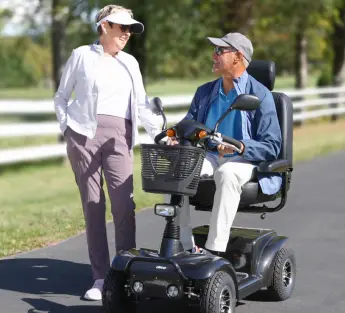Wheelchair Back & Seat Angle
The angle of the seat controls stability - and safety - for the rider.
Your wheelchair seat does not necessarily need to be parallel to the ground. On custom wheelchairs, the seats are sometimes higher in the front, sloping down toward the back. The angle of the seat compared to the ground is known as "seat dump" or "rake."
Having some degree of seat dump means that more of your weight presses against the wheelchair back making you feel more stable in your seat. People with higher level spinal disabilities gain security and safety with the use of seat dump. Manual riders are able to exert more push with less effort through their arms and shoulders.
Many chairs have the ability to adjust seat dump. The rigid frame designs in ultra-light wheelchairs, and the modularization of power designs made it easier to adjust the angle of the seat, since the seat support rails are no longer part of the chair’s folding mechanism. On a folding wheelchair these rails are fixed, so to change the seat angle you can change the position of the wheel axles relative to the entire frame. Raising the rear axles to a higher position has the effect of lowering the rear of the wheelchair and so increases the seat dump. It might also be possible to raise the caster height or use different size casters, achieving the same effect.
There are tradeoffs for the advantages of seat dump:
- When your knees are raised relative to your thighs, the pelvis rotates backwards with your legs, and the spine is flexed into a rounded shape, flattening out the lumbar curve which plays an important role in the health of your spine. Too much dump, therefore, can increase the risk of scoleosis or disk problems, so should not be used to an extreme. If you experience back pain after using more seat angle, you should adjust it toward a more level angle.
- You need to have sufficient hip flexibility to bend at the waist for added seat dump. Closing the hip angle too much can limit circulation to the legs, already at risk of circulation difficulties from not being used.
- Seat dump can add pressure and shear forces at your sacrum, increasing the risk of skin breakdown. The cushion or chair back can sometimes account for seat dump to minimize contact.
- Finally, a more pronounced seat dump might make it more difficult for you to transfer in and out of your wheelchair.
- Speak to one of our Product Specialists to determine what seat angle will be best for you
| Shop for a power wheelchair |





 Contact Us
Contact Us
 M-F 9am - 6pm ET
M-F 9am - 6pm ET
 Request parts
Request parts Request Service
Request Service
